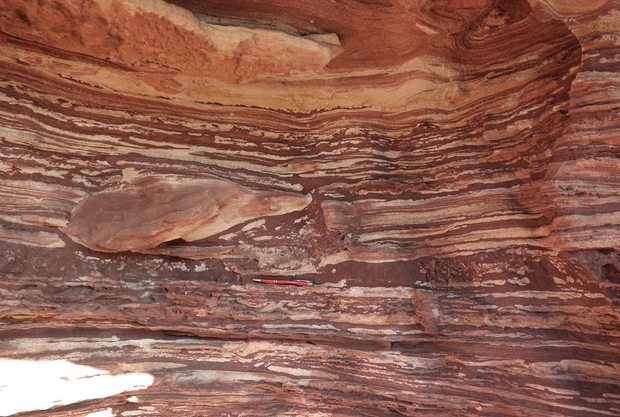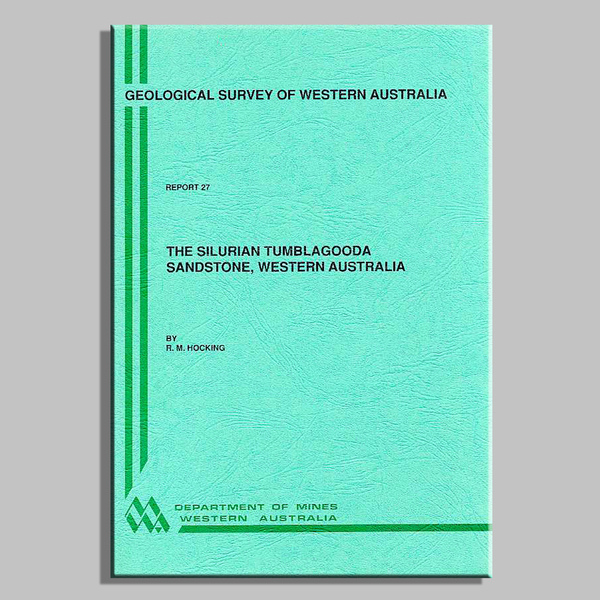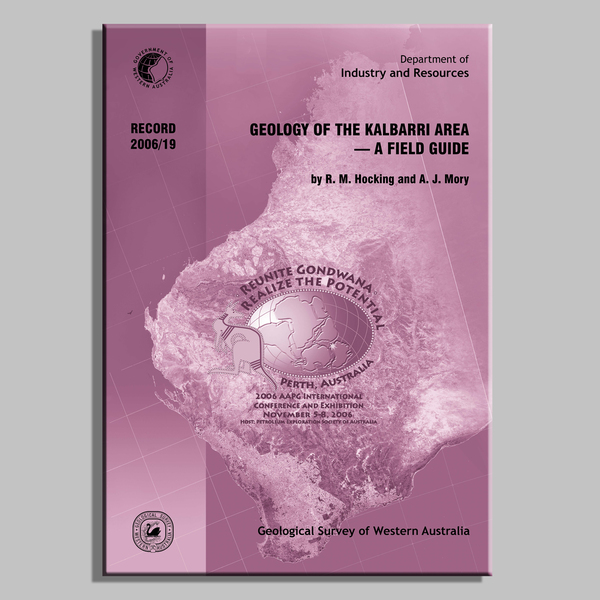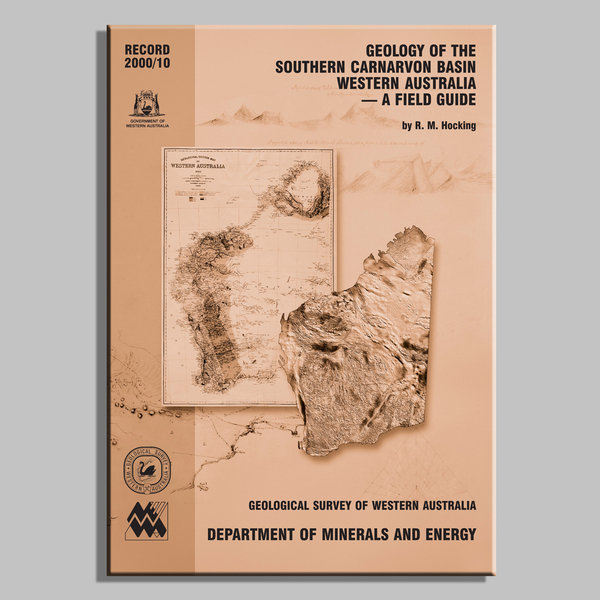Western Australia is well known for its very old rocks, but it also has many significant localities of younger rocks (Phanerozoic, less than 541 million years). Geologists working on trace fossils in the Tumblagooda Sandstone have identified a significant assemblage of trackways and burrows that provide an intriguing insight to a strange, arthropod-dominated ecosystem well before dinosaurs ruled the Earth. The following describes the Tumblagooda Sandstone and its formation and landscape, as well as the aquatic and terrestrial traces of life it preserves.
Tumblagooda Sandstone
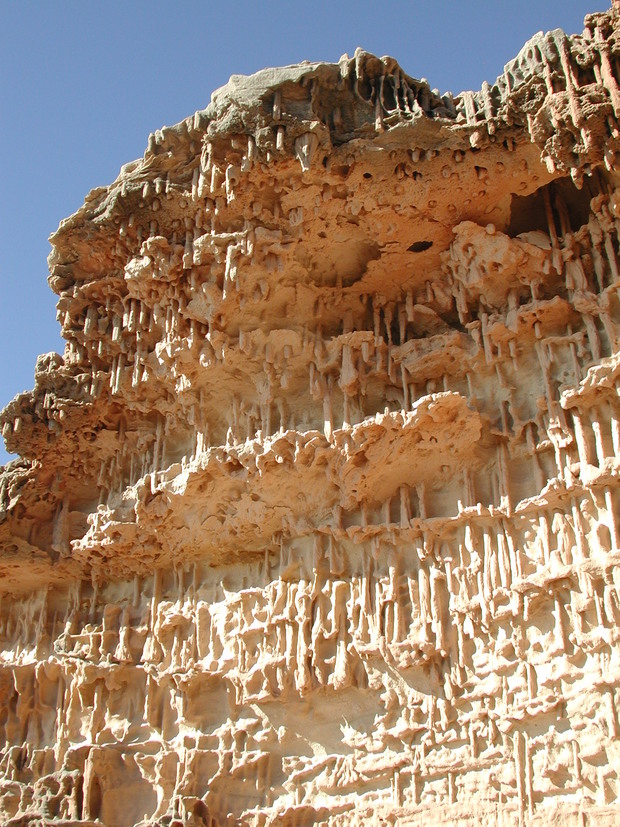
The Tumblagooda Sandstone outcrop in the Kalbarri National Park, 600 kilometres north of Perth, and features red and white rocks. The Tumblagooda Sandstone is a sedimentary rock, deposited as successive layers of sand. These layers form the colourful horizontal banding, or bedding, seen along the coast’s gorges and cliff sections.
The red and white striping and blotching of the sandstone is caused by iron oxides staining the rocks. The colouring probably formed shortly after the rock was deposited, in an oxygen-rich (rather than stagnant or swampy) environment. The colouring often highlights sedimentary features such as burrows and ripples.
Early Tumblagooda Sandstone landscape
The sediments exposed around what is presently the Murchison River, were formed on a broad (more than 100 kilometre-wide) plain covered by a continuous sheet of constantly shifting river channels, with minimal land vegetation to bind the channel banks.
When the Tumblagooda Sandstone was deposited, Australia was still adjacent to land masses now part of Asia, India and Antarctica, and the plain and its river channels were influenced by a large inland sea. The tidal range during this time may have been larger than today, and the boundary between the river plain and the tidal flats would have been irregular and constantly changing.
Abundant trackways indicate that a wide variety of arthropods were living in both the river channels and tidal flats in the Kalbarri region. This interpretation agrees with fossil evidence elsewhere in the world, which suggests that this was a time of intense evolution and adaptation for arthropods, who rapidly became important contributors to a wide range of ecosystems, and were the dominant animals living on the land. Arthropods aren’t the only animals seen in the Tumblagooda Sandstone though, as intensely burrowed layers of sedimentary rocks indicate worms mined the sediments just beneath the flats in search of nourishment, as occurs in coastal flats today.
Ichnology
Ichnology is the study of trace fossils (ichnofossils), which indicate an organism’s behaviour, such as locomotion, feeding, burrowing, escaping and even defecating. Trace fossils can be used by paleontologists to understand the environment of deposition of sedimentary rocks, and sometimes their age.
An ichnofauna is a collective of traces left by organisms. Ichnofaunas, especially those formed in marine environments, can be restricted to very specific conditions or water depths. These types of studies can be used by petroleum companies to understand hydrocarbon resources.
Signs of life
Only one body fossil has been found so far in the Tumblagooda Sandstone — an impression of a strange arthropod called Kalbarria, which belongs to a now-extinct group called the euthycarcinoids. Body fossils are rare in the sandstone because the depositional environment was not favourable for the preservation of organic material. This is because the active, high-energy river system would have quickly broken down any carcasses, and the water’s high oxygen level would have rapidly decayed flesh. Despite this, the sandstones are rich in signs of life, preserving abundant tracks, traces and burrows of organisms that lived while the sandstone was being deposited. These ichnofossils give us an insight into not only what organisms were present while the sandstone was forming, but also what the environment was like.
Ichnofossils of the Tumblagooda Sandstone are comparable to those of the Devonian Taylor Group in Antarctica and the Ordovician–Silurian Mereenie Sandstone at Kings Canyon in central Australia. The majority of traces in the Tumblagooda Sandstone were formed by animals living under water, called aquatic or subaqueous. However, some trackways seem to indicate that they were formed above the water.
Terrestrial traces
The terrestrial traces seen in the Tumblagooda Sandstone consist of many types of Diplichnites, a walking trace. Diplichnites are trackways, made up of a pair of parallel rows of ‘pits’ or paddle-like impressions, which can extend over surfaces for many metres. Tracks made in sands that were either very dry or very wet often lack definition, but those made in just the right conditions have exceptional detail preserved.
Diplichnites traces are interpreted to be formed by arthropods walking over a sediment surface, so the range of walking trails indicates the area was populated by a diverse fauna of arthropods during deposition. When the trails are well preserved, scientists can count how many legs the trace-maker had, helping to identify the arthropods that made which traces.
Aquatic traces
There are many examples of aquatic or subaqueous burrows in the Tumblagooda Sandstone. A few of the more common types include:
- Skolithos: a simple vertical or near vertical burrow that can be tens of centimetres in length, with some examples up to 2 m long
- Heimdallia: forms intensely burrowed beds with a ‘can of worms’ appearance in tidal sandflat deposits
- Psammichnites: a horizontal, gently meandering trail, possibly created by a marine snail crawling or grazing
- Tumblagoodichnus hockingi: a trace unique to the Tumblagooda Sandstone. A probable arthropod hunting burrow, named after GSWA geologist Roger Hocking — who discovered it during the first detailed study of the Tumblagooda Sandstone.
Age of the Tumblagooda Sandstone
The age of the Tumblagooda Sandstone is currently poorly constrained, with previously documented ages ranging from the Cambrian to the Cretaceous. At present, the most likely age is thought to be Ordovician or Silurian. Scientists from GSWA and elsewhere are working on new techniques to find out exactly when this formation was deposited.
More information
Western Australian fossil law
In Western Australia, fossicking and fossil collecting is permitted under the following conditions:
- collectors first obtain a Miner’s Right from the Department of Mines, Industry Regulation and Safety (DMIRS)
- written permission has been granted when collecting on people’s property or pastoral leases
- no collecting is to be made on Crown Reserves (e.g. National Parks, State Forest areas, regulated Geoheritage Reserves) without prior written approval from the relevant State or Federal Government agencies. The only exceptions to this are those State Reserves listed as having a Common, Public Utility or Mining purpose.
All collectors are encouraged to bring interesting fossils to either GSWA or the Western Australian Museum for identification. Understanding what fossils are found and where helps scientists better understand the geology of the State and helps government correctly identify and regulate important fossil sites for future generations.
It should be remembered that any Australian fossils sent overseas (even for non-commercial purposes) are subject to Federal Heritage laws. See the Federal Moveable cultural heritage website for more information.
Many of the fossils discussed here, including the Trendall locality ‘egg carton’ stromatolites, can be seen in the Western Australian Museum’s Origins gallery.
External links covering a range of topics relating to Australian fossils, paleontology and geological time can be found on External website.
Contact
For more information contact:
paleontology@dmirs.wa.gov.au

.jpg)
